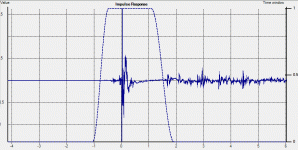
The solid line at the bottom of this measurement of Monster Massive is the THD. (The phase and SPL are also on the same graph.)
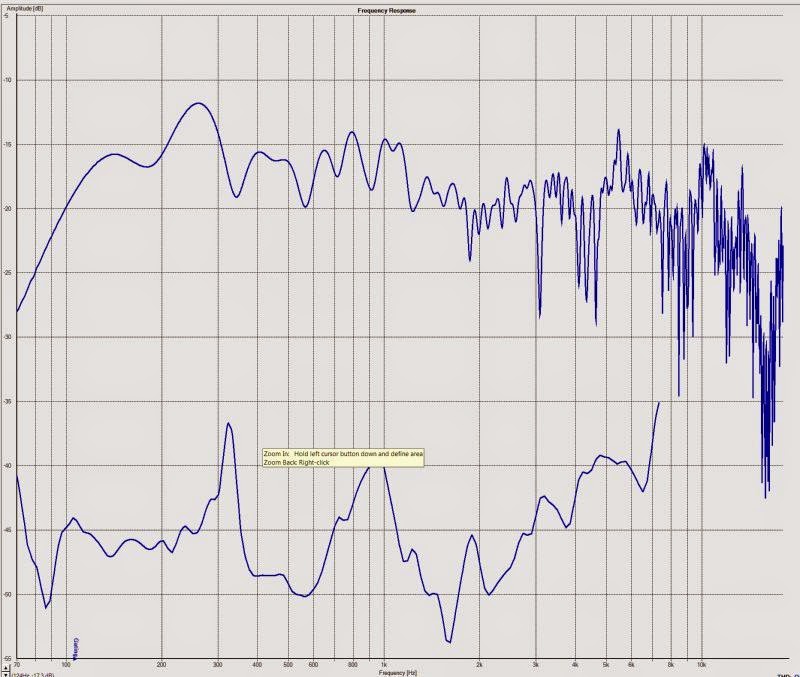
Here's the THD of the SH50. While it's true that the THD of the SH50 is lower, I think it's remarkable that the $20 Vifa and the $30 Daytons keep up as well as they do. This is something I've been saying for a few years; these little Dayton ND91s are beasts. Although they look like cheezy computer speakers, their performance is remarkable for their size and cost.
Ironically, the main source of distortion in Monster Massive is the TC Sounds fifteen!
Can you upload the file for that if you kept it?
Here's some unsmoothed and smoothed polars, done in slightly more optimum conditions. Moved the SH50 into the middle of my living room, pointed it straigt up towards a 16' high ceiling.
Can you upload the file for that if you kept it?
I've just been taking screen caps. Didn't save anything

Here's a measurement of the Danley SH50, and each one of my Gedlee Summas.
I know what you're thinking, why is there a midrange suckout?
For years I've argued that my Summas sound better at a distance. In Oregon I had a big ol' house, and a ginormous living room for my Summas. Here in San Diego, my home is the size of a postage stamp, and the Summas have been relegated to the garage.
For years I *thought* the speakers sounded better at a distance. Turns out I was wrong. You need to be equidistant from the woofer and the compression driver.
An externally hosted image should be here but it was not working when we last tested it.
Here's Earl's Summas. Looks to me that those stands are tilted back a bit.
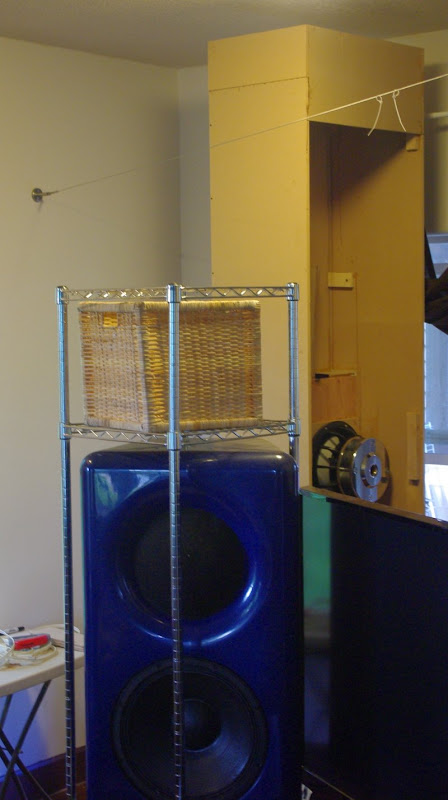
When I had my Summas in Oregon, I had them a meter off of the floor. This would have the effect of equalizing the pathlength from woofer to compression driver.
Here's why we want to equalize that pathlength:
The crossover point is 900hz. 900hz is 38cm long. Due to that, if the pathlengths of the woofer and the compression driver vary by more than 9.5cm (3.74"!!!) you're going to start seeing a suckout. The suckout is caused by a phase shift between the woofer and the tweeter.
This is really kind of a bummer, because if I'd known this six years ago I would have simply built some stands for the speaker, or at least set them up so that the nulls are pointed at the ceiling and the floor, not my face!
On the upside, there's lots to like here, once you move your mic to the correct vertical axis:
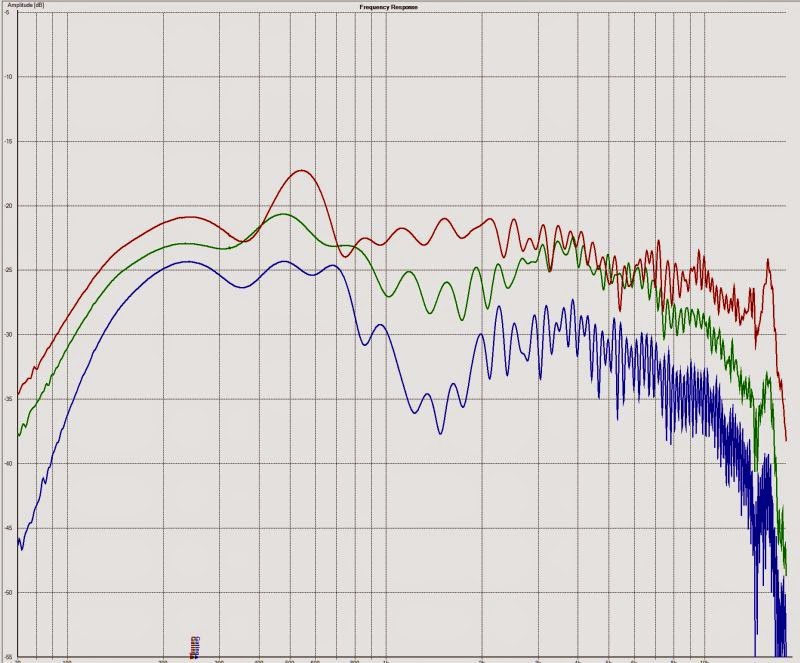
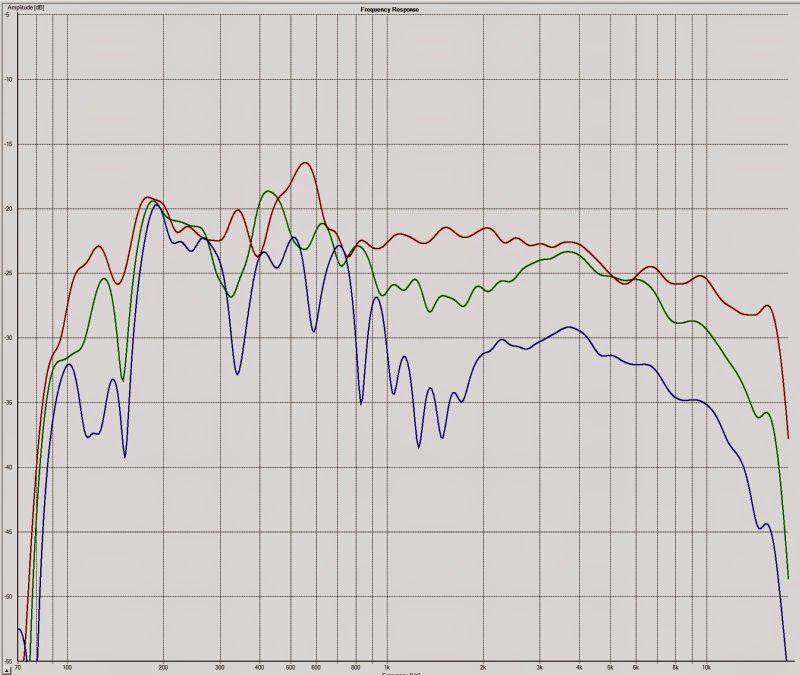
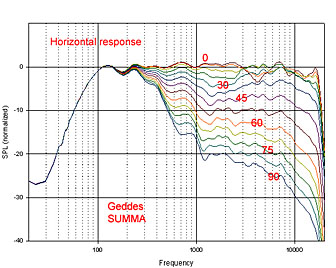
Here's the unsmoothed polars of my Summas, the smoothed polars, and the published polars.
1) The high frequency directivity of the Summa is superior to the SH50
2) The SH50 has greater output per watt. This is because there are two woofers in parallel at low frequency, and *four* midranges in series-parallel at the crossover. Thos midranges really bump up the efficiency in the midrange, relieving the load on the compression driver. In the measurement above, the Summa and the SH50 are measured at identical "volume" on my amp, but the SH50 is drawing more voltage.
When I had my Summas in Oregon, I had them a meter off of the floor. This would have the effect of equalizing the pathlength from woofer to compression driver.
Here's why we want to equalize that pathlength:
The crossover point is 900hz. 900hz is 38cm long. Due to that, if the pathlengths of the woofer and the compression driver vary by more than 9.5cm (3.74"!!!) you're going to start seeing a suckout. The suckout is caused by a phase shift between the woofer and the tweeter.
This is really kind of a bummer, because if I'd known this six years ago I would have simply built some stands for the speaker, or at least set them up so that the nulls are pointed at the ceiling and the floor, not my face!
What was a meter off the floor? WG axis, the top of the speaker, or? If you had them on the floor for a time I could see you potentially being in a null, depending on what Earl used for the design axis. They are bigger speakers, and with that kind of distance between the tweeter and the woofer you need to be a little ways away to get good integration.
Are any of the data you've posted here gated? It looks like it says "gated" really small at the lower cutoff but it's hard to tell.
Thank you for the off axis comparisons of your wg with and without the midrange taps
 . I've yet to see that kind of data and that's something I've been looking hard at since I'm thinking about building some big Synergy horns next year. I've got a fiberglass wg I built that I used to make a mold and I was planning on making a mini-Synergy this winter out of that to look at the off axis effects of the mid taps. That would make or break a Synergy build for me. I think the diffraction from the mid taps is often overlooked but it looks fairly significant from what you've shown.
. I've yet to see that kind of data and that's something I've been looking hard at since I'm thinking about building some big Synergy horns next year. I've got a fiberglass wg I built that I used to make a mold and I was planning on making a mini-Synergy this winter out of that to look at the off axis effects of the mid taps. That would make or break a Synergy build for me. I think the diffraction from the mid taps is often overlooked but it looks fairly significant from what you've shown.
Which curve is the SH50 and which curve is the Summa? Did you gate or something, there is no bass below 100Hz?
I am surprised how rippled everything is - are these room effects or the speaker? I would have expected both the SH-50 and Summa to be flatter (room suckout, notwithstanding).

Which curve is the SH50 and which curve is the Summa? Did you gate or something, there is no bass below 100Hz?
I am surprised how rippled everything is - are these room effects or the speaker? I would have expected both the SH-50 and Summa to be flatter (room suckout, notwithstanding).
The SH50 is about 6-8dB hotter than the Summa, due to a combination of lower impedance, horn loading of the midranges, and more displacement than the Summa. (The SH50 has dual 12s, the Summa has a single 15.)
In the graph above, note that there are two Summas on the same graph. I measured both to make sure that the dip in the mids wasn't due to a driver being reversed in the crossover. As you can see, the two speakers match up with a decibel or two.
Last edited:
What was a meter off the floor? WG axis, the top of the speaker, or? If you had them on the floor for a time I could see you potentially being in a null, depending on what Earl used for the design axis.

In Oregon, the wire shelf I used for the speaker put the center of the speaker at eye level. So the bottom of the speaker was a meter off of the floor.
They are bigger speakers, and with that kind of distance between the tweeter and the woofer you need to be a little ways away to get good integration.
I always noticed they sounded better far away. I now realize that I wasn't listening on the right axis, vertically. These speakers are screaming for a sloped baffle, or at least stands that tip them backwards.
Are any of the data you've posted here gated? It looks like it says "gated" really small at the lower cutoff but it's hard to tell.
All the unsmoothed data is gated. In Holm I can't tell if it ignores the gate when you smooth the measurement.
Thank you for the off axis comparisons of your wg with and without the midrange taps. I've yet to see that kind of data and that's something I've been looking hard at since I'm thinking about building some big Synergy horns next year. I've got a fiberglass wg I built that I used to make a mold and I was planning on making a mini-Synergy this winter out of that to look at the off axis effects of the mid taps. That would make or break a Synergy build for me. I think the diffraction from the mid taps is often overlooked but it looks fairly significant from what you've shown.
Yeah the taps seem to have a real effect on the compression driver.
Note that the distortion throughout the midrange is basically nil.
So I think there's an argument to be made for dual midranges at home, instead of four, to reduce the number of taps.
Maximum output will suffer, but the only weak link output wise is the tweeter and the woofer. The midranges have output to burn.
Last edited:
Well yeah, that's the fairly narrow forward lobe, root of much bickering about asymmetric waveguides vs round and c-to-c spacing and so on.You need to be equidistant from the woofer and the compression driver.
I think the diffraction from the mid taps is often overlooked but it looks fairly significant from what you've shown.
An externally hosted image should be here but it was not working when we last tested it.
This was not that significant if you look at the synergy horn Legis made. He has 11cm dia mid injection holes on either side of the throat of the CD and covering them up did not change much.
http://www.diyaudio.com/forums/subwoofers/258706-study-dipole-cardioid-bass-horn-23.html#post4016190
An externally hosted image should be here but it was not working when we last tested it.
Yes it does - you're choosing one or the other. The tightly-spaced ripples in the recent pics probably indicate mean gate your gate is a little too many samples long and is starting to get into the first major reflection. It's a lot easier to look at the impulse than guess, though. Unless you're really too close to something, the first reflection ain't hard to see and then you just move the gate ahead of it (example attached).All the unsmoothed data is gated. In Holm I can't tell if it ignores the gate when you smooth the measurement.
Attachments
Here's some random anecdotes I noticed with the SH50s in the house:
1) At one point I had two SH50s and a Summa in the living room. My wife's eleven year old daughter was sitting two feet away from the SH50. She asked "is it on?" It was. She was sitting right next to the cabinet and it wasn't immediately obvious that it was on.
2) I was doing some frequency response measurements. They looked wonky. The overall shape was correct, but their was a lot of comb filtering. It turned out I had the wrong speaker turned on. So even though the mic was in front of the wrong speaker, the response was fairly close to what you'd expect, plus comb filtering.
3) There was a couple times when *I* had to check to make sure they're on. There's something about such a large horn, you really have to stick your head in the mouth to be 100% sure where the sound is coming from. It's really bizarre that such a humongous speaker disappears sonically. I really want to hear a Jericho now.
1) At one point I had two SH50s and a Summa in the living room. My wife's eleven year old daughter was sitting two feet away from the SH50. She asked "is it on?" It was. She was sitting right next to the cabinet and it wasn't immediately obvious that it was on.
2) I was doing some frequency response measurements. They looked wonky. The overall shape was correct, but their was a lot of comb filtering. It turned out I had the wrong speaker turned on. So even though the mic was in front of the wrong speaker, the response was fairly close to what you'd expect, plus comb filtering.
3) There was a couple times when *I* had to check to make sure they're on. There's something about such a large horn, you really have to stick your head in the mouth to be 100% sure where the sound is coming from. It's really bizarre that such a humongous speaker disappears sonically. I really want to hear a Jericho now.
This was not that significant if you look at the synergy horn Legis made. He has 11cm dia mid injection holes on either side of the throat of the CD and covering them up did not change much.
I've seen 0 axis response comparisons before..... I'm talking off axis. I don't think a piece of tape over that large of an opening is sufficient to make the comparison anyways.
I've seen 0 axis response comparisons before..... I'm talking off axis. I don't think a piece of tape over that large of an opening is sufficient to make the comparison anyways.
The best way to compare horn before and after is to measure it with a compression driver, drill holes in there, and measure again.
I think tape over the port holes would likely act like a passive radiator. And a passive radiator actually might work for the midrange ports.
In Oregon, the wire shelf I used for the speaker put the center of the speaker at eye level. So the bottom of the speaker was a meter off of the floor.
A meter to the bottom.......... elevated seating?
A meter to the bottom.......... elevated seating?
Yes.
I don't think I ever posted pics. For a while there I had an elevated seating setup. It was basically and 8' x 8' raised seating area, with eight subwoofers in the floor.
I even remember the name of the thread ("eight is enough") but I can't seem to find it.
I trashed the setup pretty quickly, eight cheaps subs don't sound much better than two cheap subs. But that was the best setup for the Summas, and I'd always thought it was because the speakers were so far away, about four or five meters. But I was wrong, it was because that setup raised the Summas quite a ways off the floor.
Patrick
Thanks for the measurements! Synergy horns brought my interest ever since I heard of them in that forum, and both DIY and licensed variations look interesting. There are some major resonances apparent though, and I wonder whether point-sourciness and phase-linearity are more important for proper sound after all. Do you plan to EQ them flat?
Also, please, post the impulse responses of Summa and SH-50 here. Sorry if I start to sound like a broken recording I only wish to compare the time-domain stuff like diffraction, HOMs and mouth reflections between those two horns. Earl Geddes stresses how his waveguides and designs are optimized to eliminate those time-domain abnormalities, and how Synergy horns by their very nature are going to suck because of their non-OSWG geometry, sharp edges, holes, etc. Is that a real concern?
I only wish to compare the time-domain stuff like diffraction, HOMs and mouth reflections between those two horns. Earl Geddes stresses how his waveguides and designs are optimized to eliminate those time-domain abnormalities, and how Synergy horns by their very nature are going to suck because of their non-OSWG geometry, sharp edges, holes, etc. Is that a real concern?
Thanks for the measurements! Synergy horns brought my interest ever since I heard of them in that forum, and both DIY and licensed variations look interesting. There are some major resonances apparent though, and I wonder whether point-sourciness and phase-linearity are more important for proper sound after all. Do you plan to EQ them flat?
Also, please, post the impulse responses of Summa and SH-50 here. Sorry if I start to sound like a broken recording
Thanks for all the measurements mate. Must be fun playing with real SH50 at home. Do you enjoy the music they make?
I really don't know what more an audiophile would want. I'd all but given up on the concept of soundstaging til I heard the SH50s. The Vandersteens were the first speaker I've owned where you could beging to pinpoint sounds in the stage; that 'Dolby Atmos' type effect where a sound is neigther right or center, but somewhere in between. The SH50s do this, but with greater focus. (I know I've mentioned this before, but they sound darn near identical to Vandersteens.)
They're abusively heavy. Due to the black finish and square mouth, they actually kinda 'disappear' into the decor, and I could see someone having these in their living room.
I played my wife's favorite singer and she started tearing up listening to it. Ever seen a speaker do that?
- Status
- This old topic is closed. If you want to reopen this topic, contact a moderator using the "Report Post" button.
- Home
- Loudspeakers
- Multi-Way
- Monster Massive
